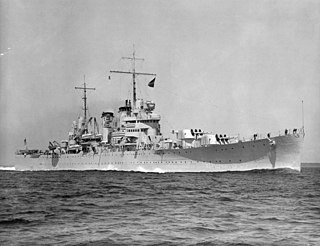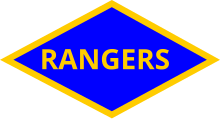
The 82nd Airborne Division is an airborne infantry division of the United States Army specializing in parachute assault operations into denied areas with a U.S. Department of Defense requirement to "respond to crisis contingencies anywhere in the world within 18 hours". Based at Fort Liberty, North Carolina, the 82nd Airborne Division is part of the XVIII Airborne Corps. The 82nd Airborne Division is the U.S. Army's most strategically mobile division.

The Battle of Anzio was a battle of the Italian Campaign of World War II that took place from January 22, 1944 to June 5, 1944. The operation was opposed by German forces in the area of Anzio and Nettuno.

William O. Darby was a career United States Army officer who fought in World War II, where he was killed in action at age 34 in Italy. He was posthumously promoted to brigadier general. Darby was the founding commander of the First Ranger Battalion, which evolved into the United States Army Rangers. He was subsequently portrayed by James Garner in the 1958 theatrical film about Darby's career titled Darby's Rangers.
The Battle of Cisterna took place during World War II, on 30 January–2 February 1944, near Cisterna, Italy, as part of the Battle of Anzio, part of the Italian Campaign. The battle was a clear German victory which also had repercussions on the employment of U.S. Army Rangers that went beyond the immediate tactical and strategic results of the battle.

United States Army Rangers are U.S. Army personnel who have served in any unit which has held the official designation of "Ranger". The term is commonly used to include graduates of the Ranger School, even if they have never served in a "Ranger" unit; the vast majority of Ranger school graduates never serve in Ranger units and are considered "Ranger qualified".

The 75th Ranger Regiment, also known as Army Rangers, is the premier light infantry unit and special operations force within the United States Army Special Operations Command. The regiment is headquartered at Fort Moore, Georgia and is composed of a regimental headquarters company, a military intelligence battalion, a special troops battalion, and three Ranger battalions.

The 9th Infantry Division is an inactive infantry division of the United States Army. It was created as the 9th Division during World War I, but never deployed overseas. In later years it was an important unit of the U.S. Army during World War II and the Vietnam War. It was also activated as a peacetime readiness unit from 1947 to 1962 at Fort Dix, New Jersey, and Fort Carson, Colorado, and from 1972 to 1991 as an active-duty infantry division at Fort Lewis, Washington. The division was deactivated in December 1991.
The Fallschirm-Panzer-Division 1. Hermann Göring was a German Luftwaffe armoured division. The HG saw action in France, North Africa, Sicily, Italy and on the Eastern Front during World War II. The division began as a battalion-sized police unit in 1933. Over time it grew into a regiment, brigade, division, and finally was combined with the Parachute-Panzergrenadier Division 2 Hermann Göring on 1 May 1944 to form a Panzer corps under the name Reichsmarschall. It surrendered to the Soviet Army near Dresden on 8 May 1945.

The 1st Ranger Battalion, currently based at Hunter Army Airfield in Savannah, Georgia, United States, is the first of three ranger battalions belonging to the United States Army's 75th Ranger Regiment.

The 2nd Ranger Battalion, currently based at Joint Base Lewis–McChord south of Seattle, Washington, United States, is the second of three ranger battalions belonging to the United States Army's 75th Ranger Regiment.

The 3rd Ranger Battalion is the third of three Ranger Battalions belonging to the United States Army's 75th Ranger Regiment. It is currently based at Fort Moore, Georgia

The 14th Infantry Regiment is a United States Army light infantry regiment. It has served in the American Civil War, Boxer Rebellion, World War II, Korean War, Vietnam War, Operation Restore Hope, Operation Uphold Democracy, Operation Joint Guard, Operation Desert Storm, Operation Enduring Freedom, Operation Gothic Serpent, Operation New Dawn, Operation Resolute Support, and Operation Iraqi Freedom. The 14th Infantry Regiment did not take part in combat during World War I. It has also conducted peacekeeping and humanitarian missions in the Sinai Peninsula, Guantánamo Bay in Cuba, Bosnia, and Kosovo.

The Queen's York Rangers (RCAC) is a Canadian Army Primary Reserve Royal Canadian Armoured Corps regiment based in Toronto and Aurora. The regiment is part of 4th Canadian Division's 32 Canadian Brigade Group. The regiment consists of one cavalry squadron, as well as the Headquarters and Training Squadron. The regimental family also includes The Queen's York Rangers Band (volunteer), along with two Royal Canadian Army Cadet corps and a Royal Canadian Air Cadet squadron. The unit mottos are pristinae virtutis memor – 'remembering their glories in former days' – and celer et audax – 'swift and bold'. Among its own members and those of other regiments, the unit is referred to as the Rangers. The name is abbreviated as QY Rang, and sometimes pronounced KWY-rang.
The 75th Infantry Regiment (Ranger) (officially 75th Infantry Regiment or 75th Infantry) was initially a parent regiment for all the US Army Ranger units during the Vietnam War and the early 1980s and then the headquarters for the Ranger battalions.

The 4th Infantry Division "Livorno" was a infantry division of the Royal Italian Army during World War II. The Livorno was classified as a mountain infantry division, which meant that the division's artillery was moved by pack mules instead of the horse-drawn carriages of line infantry divisions. Italy's real mountain warfare divisions were the six alpine divisions manned by Alpini mountain troops. The Livorno was formed on 5 April 1939 in Cuneo and named for the city of Livorno.
The 6615th Ranger Force was a regiment of the United States Army, raised for service in World War II. It served in the Italian Campaign and lost two whole battalions at the Battle of Cisterna, part of the Battle of Anzio in early 1944.

The 2nd Health Brigade (2HB) is an Australian Army brigade. The 2nd Brigade was formed in 1903 as a militia infantry formation based in Victoria, the brigade later served during the First World War as part of the Australian Imperial Force, allocated to the 1st Division. During the war, the 2nd Brigade took part in the fighting at Gallipoli, including the Battle of Krithia where it lost almost a third of its strength. Later they took part in the Battle of Lone Pine before being withdrawn back to Egypt in December 1915. Following this the brigade was transferred to the Western Front in France and Belgium where, between March 1916 and the armistice in November 1918, they took part in most of the major Allied operations.

The amphibious Battle of Gela was the opening engagement of the American portion of the Allied Invasion of Sicily during World War II. United States Navy ships landed United States Army troops along the eastern end of the south coast of Sicily; and withstood attacks by Luftwaffe and Regia Aeronautica aircraft while defending the beachhead against German tanks and Italian tanks of the Livorno Division until the Army captured the Ponte Olivo Airfield for use by United States Army Air Forces planes. The battle convinced United States Army officers of the value of naval artillery support, and revealed problems coordinating air support from autonomous air forces during amphibious operations.

The III Army Corps was one of three corps the Italian Army fielded during the Cold War. Based in the regions of Lombardy and Piedmont the corps was the army's operational reserve, while the 4th Alpine Army Corps and the 5th Army Corps, both based in the North East of Italy, were the army's front-line units. After the end of the Cold War the corps was reduced in size and on 1 December 2000 it ceded its last brigades to the 1st Defence Forces Command. The personnel of the 3rd Army Corps was used to raise the NATO Rapid Deployable Italian Corps in January 2001.

The 185th Paratroopers Reconnaissance Target Acquisition Regiment "Folgore" is an Italian Army special forces unit. The regiment is part of the Italian Army's infantry arm's Paracadutisti speciality and assigned to the Army Special Forces Command.

















